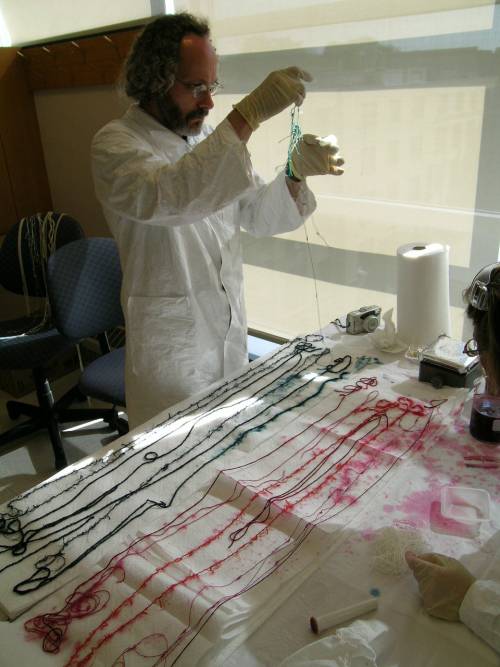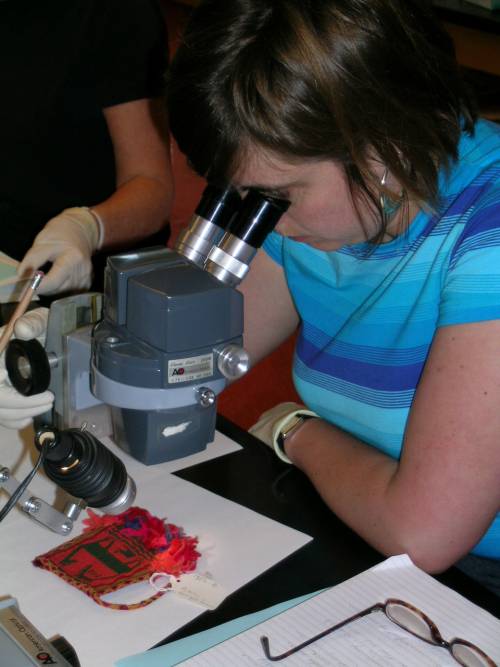
Module 2: Cloth and Other Fiber Technologies in the Andean World
Home
SIMSMC Philosophy
Description
Objectives and Design
Instructors
Program Structure
Modules
Evening Lectures
Field Trips
Schedule
June 2005 SIMSMC
Participants
Module 1
Module 2
June 2004 SIMSMC
Participants
Module 1
Module 2
June 2003 SIMSMC
Participants
Module 1
Module 2
Comments
June 2002 SIMSMC
Participants
Module 1
Module 2
Comments
Course Manuals
Travel & Housing
Who Should Apply?
NSF Support
How to contact us
Requirements for
Applicants
APPLY!
Mary Frame
Professor Linn Hobbs
Professor Heather Lechtman
Monday, 14 June
Lecture: 8:30-l1:30 am
-- The Cultural Commitment to Fibers in Andean Society (Lechtman)
Andean environment; reciprocity and complementarity; social arenas in
which fibers functioned; fiber resources; cloth and agriculture as dual
forms of wealth; pervasiveness of fiber technologies
-- The Materials Science of Natural Polymer Fibers (Hobbs)
Cotton, plant fibers, camelid wool, silk; polymer chemistry; specifics
of intra-fiber hierarchical structure; fiber microstructures; fiber morphologies
Laboratory: 1-5 pm
(a) Spinning yarn using Andean techniques (Frame), Rm. 16-605
(b) Examination of single fibers in the SEM for gross morphological features; discussion of fiber properties in relation to fiber morphologies (Hobbs), ESEM Laboratory, Rm. 13-1031 (entrance through CMSE Electron Microscope Facility, Rm. 13-1012, ground floor, south side of Building 13, accessible by stairs at south side of Building 13 or from outside)
Tuesday, 15 June
Lecture: 8:30-11:30 am
-- Why Cloth? (Frame)
Why cloth carries a heavy cultural load in the Andes; systematization,
precision, orderliness, stability of cloth technologies permit incorporation
into larger systems, like communication; technological chronology of cloth
production; survey of spinning techniques and looms
-- Color (Hobbs)
Natural pigmentation; reflective coloration using dyes; dyestuffs and
mordants: cochineal and indigo chromophores; alum, urine, and citric acid
mordants
Laboratory: 1-5 pm
(a) Warping and weaving on a body tension loom (Frame), Rooms 16-602 and 16-536
(b) Dyeing yarns of cotton, wool, silk, and assorted synthetic fibers; use of mordants with specific dyes and fibers; spectrometry of colored yarns (Hobbs), Room 16-605 and DMSE Undergraduate Teaching Laboratory, Room 8-107
Wednesday, 16 June
Lecture: 8:30-11:30 am
-- The Paradigm of Twist: mechanical implications for single and bundled
fibers (Hobbs)
From natural assemblies to human assemblies in fiber morphology; protein
fibers (helical structures) vs silk (sheet structure); structures of plant
and protein fibers based on twist; mechanical properties of single fibers;
mechanical properties of bundled fibers: reeled, spun, plied, etc.
-- The Quipu: formatting information in the structural properties of
a fiber technology (Frame)
Technological rudiments of a viable communication system; formatting in
category sequences: number, color sets, oppositional pairs; quantitative,
accounting quipus (knots are numbers); pre-Inca quipus
Laboratory: 1-5 pm
(a) Making a quipu using the yarns dyed in lab (Frame), Room 16-605
(b) Light microscopy of weaves; weave patterns and constructions examined with the light microscope (Hobbs), Room 16-536
Thursday, 17 June
Lecture: 8:30-11:30 am
-- Signifying With the Properties of Cloth: color, direction, symmetry,
and number (Frame)
Color; direction and position; symmetrical pathways; Andean dances and
their correspondence to textile structures; pre-Inca patterning in cloth
and other media; textile structure as a template for the orderly variation
in the patterned systems of pre-Inca styles
-- The Mechanical Properties of Woven and Non-woven Cloth (Hobbs)
Isotropic and anisotropic properties of woven materials; flexibility;
diagonal stretch; tear strength; linked, looped, knotted, and twined fabrics
Laboratory: 1-5 pm
(a) Continue weaving and quipu making; introduction to braiding (Frame), Room 16-605
(b) Mechanical testing of single fibers (Hobbs), Nanotechnology Laboratory,
Room 8-110, and DMSE Undergraduate Teaching Laboratory, Room 8-107
Friday, 18 June
Lecture: 8:30-11:30 am
-- The Organization of Information in Inca tocapu and the Power of Formatting
(Frame)
Media on which tocapu occurs; finite design vs infinite pattern; differences
between tocapu and patterning systems in earlier textile styles; ethnohistoric
and ethnographic sources about tocapu; deep Andean tradition of formatting
in graphic patterns; the tocapu code: properties, format, entities, operations
-- High Strength Inca Cables: suspension bridges and building construction
(Ochsendorf)
Use of fibers for long span bridges; materials and properties of bridge
cables; techniques for rope making; strength of Inca cables; mechanics
of rope assemblies and influence of twist on strength
Laboratory: 1-5 pm
(a) Rope making, using Andean methods of plying and braiding (Frame), Room 16-605
(b) Mechanical testing of rope made in the lab; the role of structure in mechanical performance (Hobbs), Civil Engineering Structures Teaching Laboratory, Room 1-047 (basement, along Massachusetts Avenue)

Dying wool, silk, cotton and synthetic fibers with indigo and cochineal

Examining fragment of Andean textile under a low-power stereo microscope